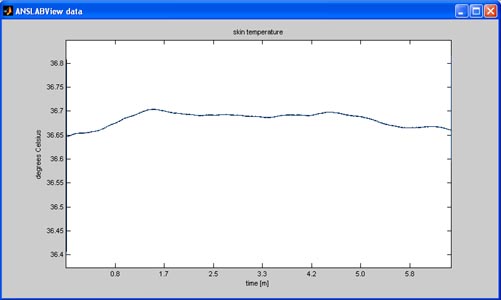
What Does This Channel
Measure?
This channel measures the temperature, typically of the subject’s
finger tip.
anslab displays temperature changes within a file as a continuous wave
in
one editing window.

What Kind of Artifacts are
Common in this Channel?
For each file, you need to decide if the signal was correctly recorded
or not. There are two main recording errors:
1. If there is a device or sendor malfunction the signal will appear as
a straight,
horizontal line, or include much noise.
2. If the sensor was incorrectly attached to the subject, the
equipment may record room temperature instead of finger
temperature. Experimenters should note the room temperature
during the experiment,
which can be compared to values of finger temperature graphed in the
display window. If the temperature does not vary much and hovers
around 20 degrees Celsius this strongly suggests artifactual data.
Also check if there are sudden spikes or irregularities in the
signal. The signal should look relatively smooth. Look for
ceiling effects - a flat line at the top of the graph. This
pattern indicates that the subject’s temperature rose above the range
of measurement, and you cannot be sure what the actual temperature
was. Though this cannot be fixed, it should be noted, and this
data excluded.
How Are Artifacts Removed?
You can use all editing tools available for raw type signal If
the file is seriously questionnable, select “set temperature channel to
missing value”. Then push the 'resume'-button and select
"Save reduced data" if you want to save your changes.
What Qualities Must Be
Preserved In Editing?
This channel rarely requires editing. The goal of editing this
channel is to identify technical errors and exclude poorly collected
data from analysis.